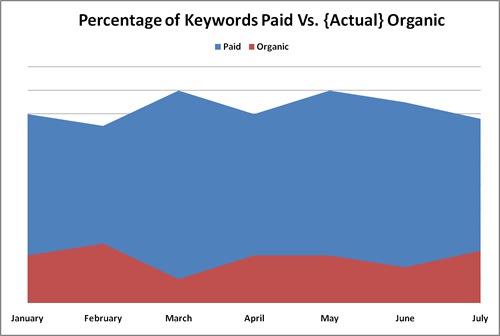When you begin working with a new SEO client, it’s always a great idea to help them understand their current state before moving forward. As part of that process, new clients might say something like, “we definitely rank for a number of keywords already, but we’re not seeing the performance we would like”. That’s a great time to start digging into their analytics package to evaluate their current keyword set.
For example, are their keywords heavily branded, contain local qualifiers, contain target keywords, etc? Although some clients can navigate their way through a keywords report, it doesn’t mean they can completely understand what’s going on organic search-wise. The beginning of an SEO engagement is a great time to provide some keyword analysis (even if it starts with a relatively basic view of what’s going on). I’ve found that some simple keyword charts can help clients clearly understand their current set of keywords, while speaking volumes about what needs to be completed SEO-wise.
Yes, You Are Ranking for Keywords, But…
I’ll provide several scenarios that you might come across and how you can quickly show a strong visual of what’s really going on. Then after presenting these charts to your clients, you could develop a plan for providing a more thorough analysis of your client’s keyword situation. Also, if I was hired to complete an SEO technical audit, then I usually present these charts in the section of the audit focused on content optimization. It makes sense if you are analyzing how well a site’s content is optimized and then provide these charts to support your findings.
Paid vs. {Actual} Organic
Depending on how sophisticated your client is, the most obvious place to start is the breakdown of paid versus organic search traffic. Although this might seem overly basic, the chart could help clients see a major discrepancy in paid versus organic keywords. I’ve worked for some clients in the past that leveraged paid search traffic for a large amount of their monthly visitors. I’ve found that showing the massive difference in organic versus paid search traffic can help gain SEO champions throughout the organization. The less a client spends on paid search, the more budget other marketing initiatives could receive (or the more budget other areas of the organization might receive). I do a lot of SEM work, but there should always be a natural balance between organic and paid search. Also, I mentioned “Actual” in the heading above. If paid search campaigns are not being tagged properly, those keywords could very well end up as “organic” in your reporting. Definitely make sure you know which keywords were truly organic or it could skew your analysis (and the perception your clients have of their current keyword set).
Showing The High Percentage of Paid Versus Organic Keywords Can Help Clients Understand an Important SEO Opportunity

Branded vs. Non-Branded
It’s great when clients rank for their branded terms, but they really should rank for them… To me, it’s not a huge win SEO-wise if company XYZ ranks for a number of terms related to XYZ. However, unless your clients are digging into their search analytics and truly understanding their keyword breakdown, they might not realize how much of their organic search traffic is coming from branded keywords. For example, you might find that branded keywords dominate and non-branded keywords are non-existent. I’ve provided a quick chart below that illustrates a client with a heavily branded keyword set. There are times during a presentation that I don’t need to say a word, which if you know me, is probably hard to believe. 🙂 By presenting the chart below, a client can quickly understand the opportunity they have.
Displaying the Breakdown of Branded Vs. Non-Branded Keywords Can Reveal a Lack of Content and/or Content Optimization

Keywords With A Local Qualifier
If you’re a local business, then keywords that contain a local qualifier are extremely important. For example, keywords that contain the town, city, zip code, or state. For local businesses, searches that are local in nature are their money terms. If you perform a quick keyword analysis for a local business client, you might find a situation where almost no keywords leading to the site contain a local qualifier. Coincidentally, that also might be why “the phone just isn’t ringing” for that business. Unfortunately, if you have no presence in local search and your company relies on (new) local business, then you’re dead in the water. The yellow pages probably can’t save you now. Depending on how sophisticated your client is, their jaw might drop when you present a chart that shows no local searches. It can also set the stage for developing a stronger local search strategy.
Percentage of Target Keywords
After performing thorough keyword research, you will typically end up with an extensive list of target keywords by theme. These are keywords that can yield thousands of other keywords that stem off of them. I’ve previously written about the power of the long tail of SEO and a client’s target keywords provide the base for the long tail. Although this might be more extensive of a project than the ones listed above (since several keyword themes will be part of the analysis), showing the percentage of keywords that led to the site that contain target keywords can be a telling story. For example, imagine your business focused on mountain bikes and only 2% of the keywords driving traffic to the site contained the words “mountain bikes” in them. That’s a simple example, but can help your client understand the content they need to create and the optimization that’s necessary.
In conjunction with showing a chart like this, you can also run a site command combined with an intitle command to show clients how many pages contain their target keywords in the title tag. This would show an obvious lack of page optimization. For example, site:yourdomain.com intitle:{target keyword}. I remember presenting an audit to a very well known CPG brand and showing their senior brand manager how none of their pages had a specific target keyword in the title tag (and it was an important keyword directly related to the category they were targeting). An awkward silence followed…
Converting Keywords vs. Non-Converting Keywords
By showing your clients the percentage of keywords driving conversion, they can clearly understand the impact of their current keyword set. Along the same lines, the percentage of keywords generating revenue is also important (for e-commerce sites). Keep in mind that conversion can mean several actions and events on your site and not just a purchase. For example, you might find that only 4% of keywords led to conversions, and that accounted for less than 10% of your revenue. Or you might find that 30% of keywords led to conversion, and that accounted for 75% of your leads. Based on your findings, you can quickly create charts to show clients what’s going on keyword-wise. At that point, you could develop a plan for identifying new keywords to target and how to rank for them.
Summary
When beginning work for new SEO clients, there are definitely some quick and effective visuals you can present that help them understand their current keywords. Your analysis can also help you set the stage for future SEO efforts. An SEO roadmap (or a list of core projects for the year) is critically important, but you first need buy-in from key stakeholders. These visuals can help you gain that buy-in. You’ve probably heard the old adage, “a picture is worth a thousand words”. Well in SEO, “a good chart can get a thousand people backing your efforts”. And that’s never a bad thing. 🙂



